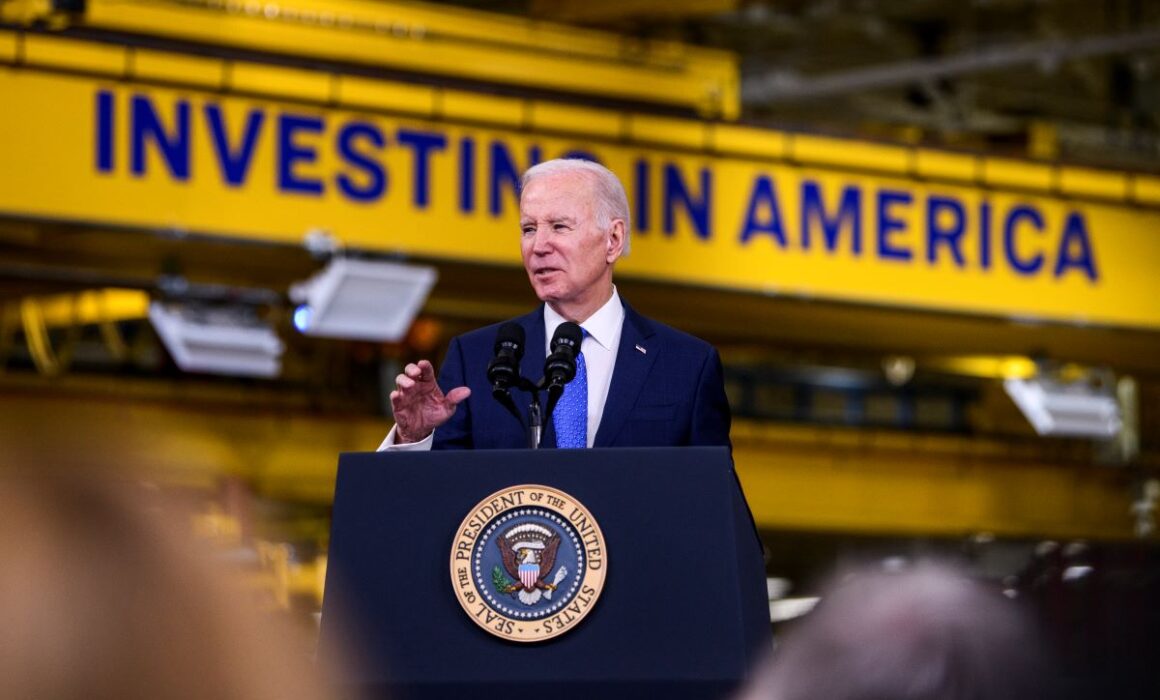Industrial Policy Synergies: Reflections from Biden Administration Alumni
April 25, 2023
By Todd N. Tucker (Foreword), Sameera Fazili, Jane Flegal, Jennifer Harris, Janelle Jones, K. Sabeel Rahman, and Tim Wu
The following collection brings together the ideas and reflections of six Biden administration alumni who helped bring industrial policy to the forefront of US economic policy. With essays by Sameera Fazili, Jane Flegal, Jennifer Harris, Janelle Jones, K. Sabeel Rahman, and Tim Wu; and a foreword by Roosevelt’s director of industrial policy and trade, Todd N. Tucker.
Note: The views expressed herein are solely those of the author of each essay, and should not be attributed to their employers—past or present. Nor should the views of any author of an essay herein be taken as endorsement of any other essay.

Stephen Maturen/Getty Images
Foreword
We are in an industrial policy moment. Just a few years ago, the International Monetary Fund (IMF) described industrial policy as “the policy that shall not be named.”1 Today, it is the explicit agenda of the Biden administration.
This is a big shift, driven by dramatic circumstances. The pandemic and supply chain, climate, and international security crises made clear that we were no longer in control of the critical industrial resources our economy needs. At the same time, it has become increasingly recognized that the old ways of policymaking drove (and sometimes were driven by) pollution and inequality—and that some communities, those with the least power, were getting the brunt of the pain.
The new thinking that has grown from this shift has been given a lot of different names—from Brian Deese’s “modern American industrial strategy”2 to Dani Rodrik’s “new productivism”3 to Ezra Klein’s “supply-side progressivism.”4
But these perspectives share a common belief that leaving it to the market to decide which industries survive and thrive is a recipe for economic vulnerability. The public—through the state, workplace organizations, and communities—can and must shape markets to serve the greater interest.
There are many opportunities and challenges for this project in the years ahead. As the wide variety of names given to this new approach hint at, many proponents have different answers for those challenges. But, we should recognize that those debates are taking place within a new, exciting, and suddenly broadly shared paradigm that offers a sharp break from neoliberal “free-market” ideology.5
Who better to share reflections at this key moment than those who have been at the forefront of this evolution in economic policy? This distinguished forum includes alumni from the Biden administration’s first two years, including from the National Economic Council (Sameera Fazili and Tim Wu), National Security Council (Jennifer Harris), Office of Domestic Climate Policy (Jane Flegal), Office of Information and Regulatory Affairs (K. Sabeel Rahman), and Department of Labor (Janelle Jones). Like a contemporary version of Franklin D. Roosevelt’s “brain trust,”6 these talented thinkers and doers are helping drive strategy both inside and outside of government. Much more so than in FDR’s time, this cohort looks like and thinks on behalf of all of America.
Industrial policy doesn’t—and shouldn’t—exist in a vacuum. As we wrote at the Roosevelt Institute in 2019, public shaping of the intra-industry composition of the economy works best when it is an all-of-government affair.7
So we asked this impressive group of authors to reflect on what synergies are needed across policy domains for industrial policy to be successful. In particular, how can macroeconomic policy, climate policy, trade policy, labor policy, inclusion policy, and competition policy help make better industrial policy, and vice versa?8
As these piercing essays show, there are lots of ways these synergies can make for better policy and human outcomes. The insights can be grouped in a few categories: better tools, better strategies and relationships, better values, and unfinished business.
Among the better tools, Fazili recommends a reconceptualization of the macroeconomic policy menu to better define when shocks can be solved by demand-side measures like reducing demand and employment, and when measures like supply-side management in particular industries are a better way to reduce prices while keeping workers whole. She canvasses how different industries like trucking or semiconductors require different policy tools, while noting there is no “one size fits all” approach for all industries—a point Flegal also explores in contrasting cost structures of different clean energies.
Sometimes, “better tools” just means using old tools in better ways, which Wu explores in the antitrust context, Jones explores in noting how Hollywood labor practices can be transferred in promising directions for fast-food workers, Fazili explores through the Defense Production Act (with its conceptual roots in the Franklin D. Roosevelt administration), and Harris explores through mineral-specific trade agreements—a nod to the commodity clubs that played a role in internationally stabilizing prices and supplies for much of the 20th century.9
Rahman notes the subtle ways that Biden’s industrial policy is evolving beyond the normal strictures of 20th century administrative state rulemaking (with defined notice-and-comment periods for the public, for example). Rahman argues for new ways of engaging the public to ensure these efforts retain legitimacy, such as citizen juries. Indeed, it is unsurprising that a transformation on the scale of the green transition would require a remaking of the tools of the administrative state. When FDR attempted to effectuate new government functions, he first created numerous agencies, and then rationalized them following the recommendations of the so-called Brownlow committee.10
On better strategies and relationships, Flegal and Wu outline the need to craft policy that also accomplishes small-p political objectives. In the climate context, this involves moving beyond a narrow market failure lens and embracing energy transitions for the system change they are. This calls for building new coalitions of climate action enablers that can overcome climate action blockers, including through delivering concrete and visible benefits to both energy and environmental justice communities. In the competition context, this means infusing industrial policy with lessons from the anti-monopoly movement as a check against private domination over the democratic public interest—a shift that Wu notes is already well underway in the Biden administration. Both Jones and Rahman argue for targeting industrial policy resources and processes to further the interests of workers of color. Both note that this is not some new government undertaking, as past economic policies—whether on manufacturing, transportation infrastructure, or other matters—were not racially neutral either.11 Wu also discusses how past development choices radically changed the very balance of power between industries and geographies in the United States.
Harris suggests that international policy cannot be treated as hermetically sealed from domestic policy in the 21st century, and lauds the Biden administration’s success in launching the Global Arrangement on Sustainable Steel and Aluminum (GASSA) to simultaneously advance worker, environmental, and China competition goals (which she calls the “Biden three-fer”). She points out how simultaneously achieving multiple objectives also opens up new geometries of trans-partisan and international alliances. One might also point to the way that the White House offices where our authors worked—the National Economic Council, National Security Council, and Climate Policy Office—unlocked new ways of working together across the foreign-domestic divide. Fazili similarly notes that there is need for new and closer relationships between suppliers in supply chains and between suppliers and government. Integrations of these systems can make the resulting policy stickier—a goal Flegal identifies as central to US credibility on climate going forward.
These case studies also help illuminate why—to the puzzlement of some pundits—Biden’s economic strategy tries to achieve multiple objectives at once.
What the administration is trying to do is not just maximize the number of a given widget in the economy, but unleash a self-reinforcing and inclusive growth dynamic.12
This multifaceted enterprise is more akin to an economy-wide economic development strategy than an individual firm’s output maximization.13
In complex policy settings, the difference between sequential and conjoint problem solving can matter greatly. What does this mean? In some cases, two policies can come sequentially, and neither is worse off for not happening at the same time. This could be the case with the GASSA, which deals with standards for steel and aluminum in a way that does not detract (and indeed might help) further sectoral deals in plastics, cement, and other products. In other cases, two policies will work better if enacted conjointly, and indeed—one might be harder to solve if the other moves first. This could be thought of as the “Elon Musk problem,” akin to when the Obama administration subsidized Tesla (Policy A) without requiring high-road, pro-union labor practices (Policy B). One could argue that it’s preferable to get electric vehicle production up and running, and then figure out improving labor practices at a later date. The problem is, Policy A enriches and empowers the subsidy beneficiary to more effectively resist Policy B later on.
A more effective policy is one that bakes in the desired targets from the beginning, as Jones persuasively describes in her call to embed sectoral bargaining in industrial policy from the moment of inception. Unions can help shoulder workplace training responsibilities (helping subsidized firms) and serve as a whistleblower to make sure funds are spent well (helping taxpayers and government). Similarly, Rahman points to the benefits of community consultation early on to make clean energy projects move faster.14 Harris’s exploration of the steel industry, and Fazili’s recounting of bringing together stakeholders in the trucking industry, attest to the value of tripartite or corporatist policy processes, bringing together labor, capital, and government. Indeed, on-the-ground union and community partners can help solve the so-called Hayekian information problem, the notion that government lacks the knowledge that collectively resides in the private sector.15
Successful industrial policy will also require better values. Harris argues that trade prerogatives shaped other policy domains for too long, and now it’s time for trade to advance more fundamental values. This is true across the areas covered in this collection. The values at the center of the new industrial policy must include environmental sustainability, racial equity, democracy, and economic liberty. Flegal argues for the existential necessity of prioritizing climate. Wu calls for a reclaiming of the virtues of economic liberty. Critically, Harris, Jones, and Rahman all point to the importance of using industrial policy to build and deepen an equitable, multiracial democracy.
Finally, each essay points to substantial unfinished business. Jones notes that only part of the Build Back Better agenda became law, and the supports for the care industry that were initially promised ended up on the cutting room floor. Likewise, Fazili notes that funds for ongoing supply chain monitoring did not make it through the CHIPS negotiations. Flegal notes that the Infrastructure Investment and Jobs Act and Inflation Reduction Act only get the US part of the way toward its climate commitments. Policymakers will have to do lots more on climate in the coming years, which is why we must unlock a politically supportive “green spiral.” Harris notes a messaging gap, where the administration can be too timid in defending its (laudable) decisions. Rahman notes a need for philanthropy to step up its infusion of resources into building an inside and outside industrial policy ecosystem.
And all the essays point in various ways to the importance of greater public faith in government, and greater government faith in itself. One of the more corrosive effects of decades of neoliberal attack on government (including through so-called “public choice” scholarship) is that bureaucrats are seen as narrow, self-interested actors who cannot and will not further the general public interest. As the economist Ha-Joon Chang notes, this can become a self-fulfilling prophecy.16 Building government back better and bolder will be a generational challenge, and will require exceptional bureaucrats who can rebuild faith in the government. We as citizens are lucky these six voices gave of their own and their family’s time to that highest calling of public service.

About the Author

Todd N. Tucker
Director, Industrial Policy and TradeAs Director of Industrial Policy and Trade, Dr. Tucker, a political scientist, helps lead Roosevelt’s work on the role of governance and institutions (both national and international) in facilitating economic transformation.
References
1Reda Cherif and Fuad Hasanov, “The Return of the Policy That Shall Not Be Named: Principles of Industrial Policy,” IMF Working Paper (Washington, DC: International Monetary Fund, March 2019), https://www.imf.org/en/Publications/WP/Issues/2019/03/26/The-Return-of-the-Policy-That-Shall-Not-Be-Named-Principles-of-Industrial-Policy-46710.
2Brian Deese, “Remarks on a Modern American Industrial Strategy by NEC Director Brian Deese,” The White House, April 20, 2022, https://www.whitehouse.gov/briefing-room/speeches-remarks/2022/04/20/remarks-on-a-modern-american-industrial-strategy-by-nec-director-brian-deese/.
3Dani Rodrik, “The New Productivism Paradigm?” Project Syndicate, July 5, 2022, https://www.project-syndicate.org/commentary/new-productivism-economic-policy-paradigm-by-dani-rodrik-2022-07.
4Ezra Klein, “What America Needs Is a Liberalism That Builds,” New York Times, May 29, 2022, https://www.nytimes.com/2022/05/29/opinion/biden-liberalism-infrastructure-building.html.
5As the historian Quinn Slobodian has noted (among others), neoliberalism’s rhetorical gestures toward the “free market” were belied by a fairly aggressive use of state power at the national and international level to protect the interests of business and elites, and shield them from democratic contestation. See Quinn Slobodian, Globalists: The End of Empire and the Birth of Neoliberalism, (Cambridge, MA: Harvard University Press, 2018).
6Rexford G. Tugwell, The Brains Trust, Compass edition (Viking, 1968).
7Todd N. Tucker, Industrial Policy and Planning: What It Is and How to Do It Better, (New York: Roosevelt Institute, July 30, 2019), https://rooseveltinstitute.org/industrial-policy-and-planning/.
8These policy areas reflect the Roosevelt Institute’s six current research areas.
9See Kabir-ur-Rahman Khan, The Law and Organization of International Commodity Agreements (Amsterdam: Brill Nijhoff, 1982); Jamie Martin, “The Global Crisis of Commodity Glut During the Second World War,” International History Review 43, no. 6 (April 6, 2021): 1273–90, https://doi.org/10.1080/07075332.2020.1871053.
10Donald R. Brand, “The [US] President as Chief Administrator: James Landis and the Brownlow Report,” Political Science Quarterly 123, no. 1 (March 1, 2008): 69–94; John A. Dearborn, Power Shifts: Congress and Presidential Representation, (University of Chicago Press, 2021), https://www.jstor.org/stable/20202972.
11Targeting material benefits is also a form of reparative policy. See Kyle Strickland and Felicia Wong, A New Paradigm for Justice and Democracy: Moving beyond the Twin Failures of Neoliberalism and Racial Liberalism, (New York: Roosevelt Institute, November 2021), https://rooseveltinstitute.org/publications/new-paradigm-for-justice-and-democracy-moving-beyond-the-twin-failures-of-neoliberalism-and-racial-liberalism/.
12These strategies are sometimes called “policy feedback loops” or “experimentalist governance.” See Jacob S. Hacker and Paul Pierson, “Policy Feedback in an Age of Polarization,” The ANNALS of the American Academy of Political and Social Science 685, no. 1 (September 1, 2019): 8–28, https://doi.org/10.1177/0002716219871222; Alexander Hertel-Fernandez, “How Policymakers Can Craft Measures That Endure and Build Political Power,” (New York: Roosevelt Institute, June 2020), https://rooseveltinstitute.org/publications/how-policymakers-can-craft-measures-that-endure-and-build-political-power/; Charles F. Sabel and David G. Victor, Fixing the Climate: Strategies for an Uncertain World, (Princeton: Princeton University Press, 2022).
13Arkebe Oqubay, Christopher Cramer, Ha-Joon Chang, and Richard Kozul-Wright, eds. The Oxford Handbook of Industrial Policy, (Oxford University Press, 2020), https://doi.org/10.1093/oxfordhb/9780198862420.001.0001.
14The loss of speed is not always due to “too much democracy,” but can also be caused by state unwillingness to use all tools at its disposal or by corporate capture. See Arnab Datta et al., “Seven Ways the Executive Branch Can Turbocharge Green Industrial Policy,” (New York: Roosevelt Institute, August 18, 2022), https://rooseveltinstitute.org/publications/seven-ways-the-executive-branch-can-turbocharge-green-industrial-policy/; Joel Dodge et al., “Progressive Preemption: How the Defense Production Act Can Override Corporate Extraction, Boost Worker Power, and Expedite the Clean Energy Transition,” (New York: Roosevelt Institute, December 9, 2022), https://rooseveltinstitute.org/publications/progressive-preemption-defense-production-act/.
15That doesn’t mean that all information could or should ever reside in government, a reality nodded to by Fazili, Rahman, and Wu.
16Ha-Joon Chang, “Breaking the Mould: An Institutionalist Political Economy Alternative to the Neo-Liberal Theory of the Market and the State,” Cambridge Journal of Economics 26, no. 5 (2002): 539–59, https://www.jstor.org/stable/23600312.




